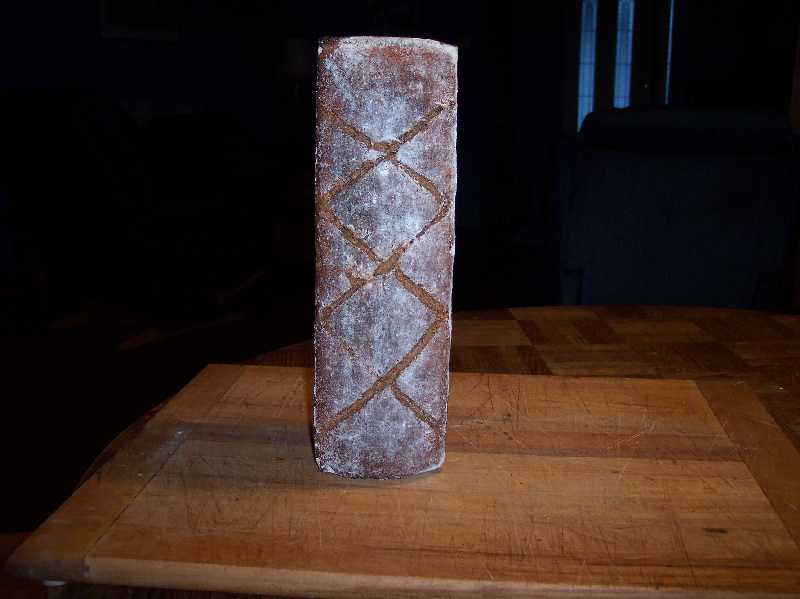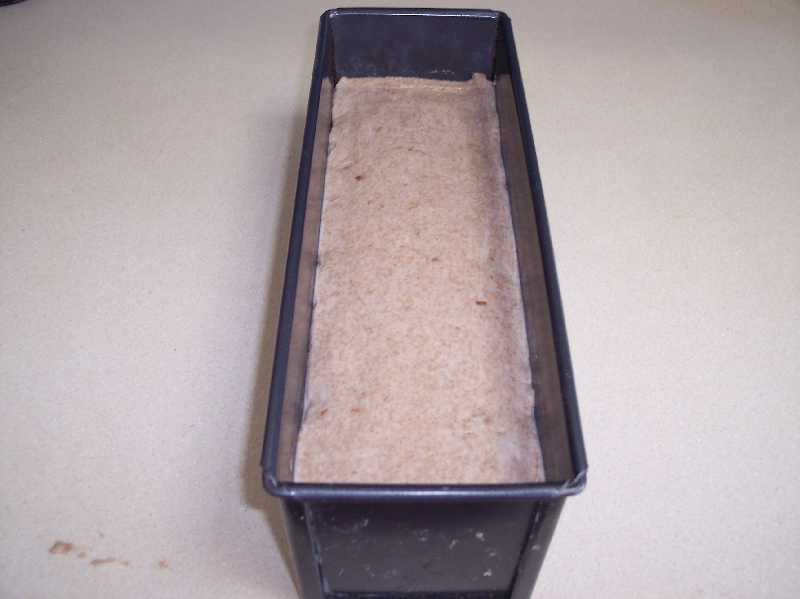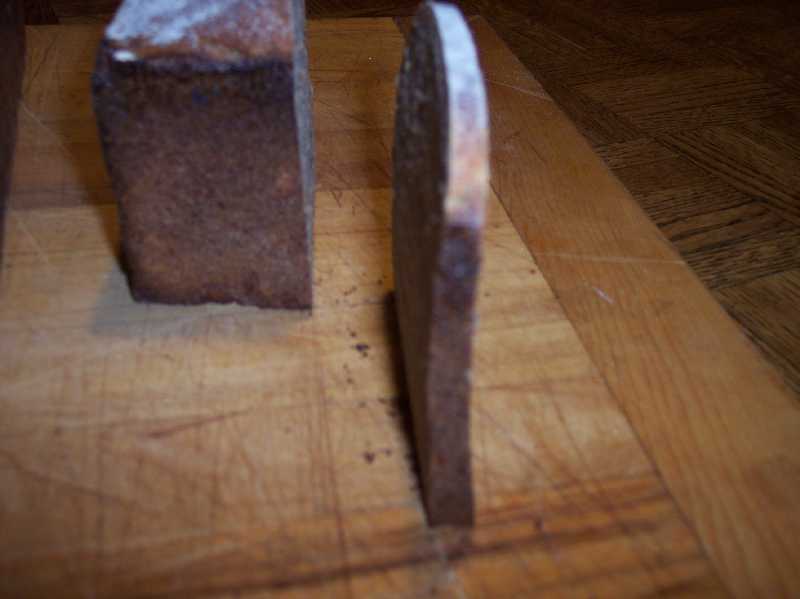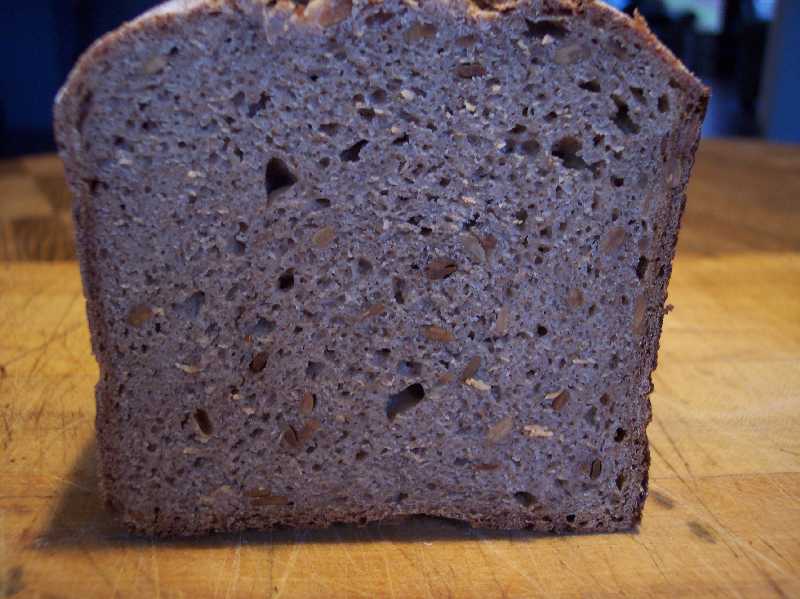
This bake started out with two things in mind. I wanted to make an 80% sour rye bread and to bake it in my Pullman pan, which I’ve used only once since I bought it this past summer. While I was looking through Hamelman's 'Bread' for a recipe to use, I stopped on the photo page showing the assorted rye breads from Chapter 6, and not for the first time thought what a marvellous display of craftsmanship it was. The one in particular that has always stood out among the others for me is the Pullman loaf at the back, sitting vertically with a series of diagonally crossed slashes the length of the loaf. I've wanted to try that slashing pattern ever since seeing it, so now I had a third thing I wanted to do, but first I needed to find a recipe to use. Unfortunately the photo in the book doesn't say what particular bread the Pullman loaf is. The only rye in the chapter other than the Horst Bandel Pumpernickel that calls for a Pullman pan is the 70% Rye with a Rye Flour Soaker and Whole Wheat Flour, and that didn't fit with what I had in mind. I decided to make Hamelman's 80% Sourdough Rye with a Rye Flour Soaker, but to make it using only natural leavening rather than the combination of sour and bakers yeast called for in his formula, and to substitute dark rye for whole rye in the soaker and final mix. Somewhere along the line I decided to throw some toasted sunflower seeds into the mix as well for a bit of added flavour and texture.
When I was making the sour/levain the night before the final mix and looking at the tiny little portion of mature sour expected to convert all that raw rye flour into the only source of leavening for this bread, I must admit I had some doubts. 18 hrs later it was clear that I had underestimated just how active my starter was. It had just about popped the lid off the container, looking more like a ripe, dark, poolish than any rye sour I've made before. Simply amazing how voracious natural yeast can be in the right environment.
Three hours before the final mix the seeds were toasted in a 350F oven for 10 minutes before I checked them for colour. I was looking for a medium to dark colour to bring out a rich nutty flavour, which I think is a key component of the overall flavour of this loaf. The time will vary for different ovens, but the smell and colour of the toasted seeds is the best indicator to watch for.
The mix was started in the stand mixer and finished by hand. In retrospect I should have done the entire thing by hand and saved myself the trouble of cleaning sticky rye paste out of every possible space it could get into on my mixer. It was just too large for my small KA to handle properly through to a finished mix, but it did get it off to a good start, needing only 2-3 minutes of handwork to develop it into a cohesive paste. Final ferment, rise and bake notes are included in the recipe to follow. Molding the bread into the pan properly is a fairly critical step to have a symmetrical finished loaf, and I spent enough time with this stage to ensure the baked loaf would be level on top and that the corners would be as even and square as possible. One thing I should point out to anyone who might make this loaf or something similar. When you place the paste in the pan, make sure that the bottom and sides of the paste are dry by blotting off any excess water from the initial molding with a towel of some kind. I didn't, and had a bit of a sticking problem in one spot when it came time to unmold the loaf. Once it had cooled a bit, along with some very gentle persuasion, it did release cleanly, but a word of caution on this point. The loaf was set to cool, wrapped in linen, for 16 hrs before slicing.
I have to say this is the best tasting hi ratio rye bread I've made so far, largely due to the sour itself, but also how well the flavour of the toasted seeds compliments not only the sour, but the dark rye flour. A thin slice of this bread has that level of flavour that lasts in the mouth for the better part of an hour and makes you want to come back for more. The crumb itself is moist and dense, and even after 6 days shows no sign of staling, due to the soaker and pan baking I'm sure. The bread is a dream to slice, yielding slices just about as thin as you could possibly want them without crumbling. Although I didn't get the nice definition on the slashing as pictured in Hamelman's 'Bread' it's a fact I can easily live with when the bread tastes as good as this one does. My favourite rye? No doubt in my mind this one is it for quite some time to come.
Franko



|
80% Sourdough Rye with a Rye-Flour Soaker and Sunflower Seeds-adapted from Hamelman's 'Bread'
|
|
|
|
Ingredients
|
%
|
Kg/Grams
|
|
Sourdough/Starter
|
|
|
|
Whole Rye Flour
|
100
|
390
|
|
Water
|
83
|
315
|
|
Mature Sourdough Rye culture @ 100%
|
5.1
|
20
|
|
Total
|
|
725
|
|
|
|
|
|
Soaker
|
|
|
|
Dark Rye Flour
|
100
|
200
|
|
Water-boiling
|
118
|
236
|
|
Total
|
|
436
|
|
|
|
|
|
Final Dough
|
|
|
|
Dark Rye Flour
|
|
200
|
|
High Gluten flour
|
|
200
|
|
Water
|
|
197
|
|
Sea Salt
|
|
20
|
|
Soaker
|
|
436
|
|
Sourdough
|
|
725
|
|
Toasted sunflower seeds
|
|
90
|
|
Total weight
|
|
2143
|
|
|
|
|
|
Overall Formula
|
|
|
|
Whole rye flour
|
40
|
400
|
|
Dark rye Flour
|
40
|
400
|
|
High gluten Flour
|
20
|
200
|
|
Water
|
72
|
720
|
|
Salt
|
1.8
|
18
|
|
Sunflower seeds
|
9
|
90
|
Notes: The total weight of this mix is scaled a little heavier than what you need for a 13x4x4 Pullman pan. Scaling weight for these pans is 2.050kg. Because the dough is very sticky, I found I lost some of the dough to my hands, paddle etc. The final weight of this formula should be more than enough to compensate for that. Scaling weight for the bread pictured was 29 grams short of 2.050 .
PROCEDURE:
Before final mixing:
Mix the sourdough and leave for 17-18 hours to ripen at 65-70F.
Next mix the soaker, cover with a lid or plastic wrap and leave over night at room temperature.
Final mixing:
DDT -80F
Mix all the ingredients except the sunflower seeds on 1st speed for 3 minutes. Adjust the hydration so that the mix is loose and sticky.
Add the sunflower seeds and mix on 2nd speed for 3 minutes. The mix should resemble a paste rather than a typical wheat based 'dough'. It should be soft and sticky.
-
Depending on the size of the mixer you may need to turn the dough out on to the counter and finish mixing by hand. If so, have your hands wet, and use a scraper to help fold the dough over itself several times until it's uniformly mixed.
Place in a bowl, cover, and let bulk ferment for 30 minutes.My dough was cool after mixing and at 74F. It was given a slightly longer 45 minute bulk ferment.
Shaping:
Using wet hands, form the paste into a log and place in the pullman pan.
-
the pan I used has only been used once previous and the glaze is intact. Because of this I didn't oil or dust the pan with flour. My preferance is that the sides of the loaf look smooth and free of flour if possible. With an older pan it should be either oiled and dusted, or lined with parchment to prevent sticking.
Press the paste into the corners of the pan with wet hands, then using a wet plastic scraper pressed flat on top of the paste, press down firmly, working the paste so that it's even along the edges of the pan on all sides. Try to get the corners as square as possible and then use the scraper to smooth and flatten the top so that it's level across the entire surface.
Final rise and baking:
Final rise of 2- 2 ½ hrs at 70-72F, covered with a clear plastic box if possible or a plastic sheet. Keep the paste damp on top if needed by spraying with water. The bread does not need to be scored, but if scoring do it just a few minutes before loading in the oven to allow the slashes open cleanly.
Bake at 465F for 15 minutes then at 435 for 45 minutes. The loaf should have pulled away from the sides of the pan, similar to the way a cake does when it's baked. Allow the loaf to cool in the pan for a few minutes before tipping it out. Cool on a wire rack, wrapped in linen, for 12 hrs before slicing.